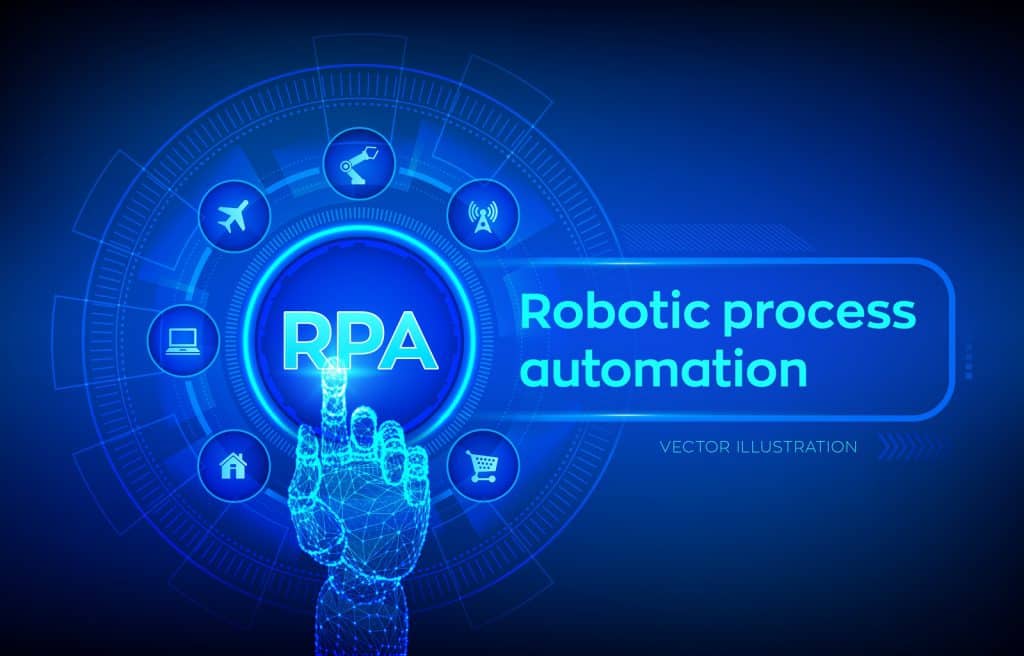We all know that time is money in business. The trouble is there’s never enough of either – especially as so much of both is wasted performing repetitive, low-value tasks. Nearly all organizations have numerous operational areas that need to execute hundreds (if not thousands) of time-consuming back-office business processes each day. Many of these processes, while moderately complex, are fundamentally rules-based, and don’t require human decision-making and judgment – yet they steal hours upon hours of employee time. Invoice processing, sales orders, payroll, bank reconciliation, data migration, and entry tasks – these are all relatively simple though tedious, repetitive, and sluggish activities when performed manually. Surely, as we head into the third decade of the 21st Century, there has to be a better way. Enter robotic process automation.
Table of Contents
ToggleWhat Is Robotic Process Automation?
In simple terms, robotic process automation (RPA) is the process of automating business processes. This is achieved using robots to both save on employee time and reduce the risk of human error.
When it comes to RPA, the “robotic” part of the term can be a bit misleading. We’re not talking about physical robots here – rather, software robots capable of automating tedious, rules-based activities, such as processing invoices, payroll, and procurement. There are some similarities, however. Just like physical robots are deployed on assembly lines to perform repetitive tasks in manufacturing and production, RPA does the same thing – only in the office. Rather than doing manual, physical labor in a factory, like physical robots do, robotic process automation bots handle repetitive, computer-based, clerical tasks – such as entering data, ordering supplies, sending shipping notices, and such.
These software robots are designed to enable a set of coded commands to communicate with – or even replace – existing systems, replicating what humans would otherwise do manually. Essentially, robotic process automation is about training software bots to mimic human actions to perform a sequence of steps – at lightning speed, with no errors, and without breaks.
Helpfully, in a recent blog post, The Enterprises Project put together a shortlist of plain-English definitions of robotic process automation from senior figures at a range of technology companies. Here are three which should help sharpen your understanding of the term:
“Robotic process automation is nothing but instructing a machine to execute mundane, repetitive manual tasks. If there is a logical step to performing a task, a bot will be able to replicate it.” – Vishnu KC, Senior Software Analyst Lead at ClaySys Technologies.
“RPA is an advanced form of business process automation that is able to record tasks performed by a human on their computer, then perform those same tasks without human intervention. Essentially, it is a virtual robot copycat.” – Marcel Shaw, Federal Sales Engineer at Ivanti.
“In layman’s terms, RPA is the process by which a software bot uses a combination of automation, computer vision, and machine learning to automate repetitive, high-volume tasks that are rule-based and trigger-driven.” – David Landreman, CPO at Olive.
And here’s a bonus definition from Deloitte: “Robotic Process Automation (RPA), often referred to as ‘robotics’ or ‘robots’, is defined as the automation of rules-based processes with software that utilizes the user interface and which can run on any software, including web-based applications, ERP systems and mainframe systems.”

(Image source: deloitte.com)
Benefits of Robotic Process Automation
The rapid growth of the global robotic process automation market is expected over the coming years. Valued at $597.5 million in 2018, the RPA market is forecast to reach $3.97 billion by 2025, registering a CAGR of 31.1%, according to Grand View Research.

(Image source: grandviewresearch.com)
Why the surge in growth? Well, there are, in fact, many reasons – chief among them being improvements in productivity.
According to research from automation Anywhere, RPA can complete tasks up to 70% faster than a human. What’s more, software robots are active and productive 100% of the time – compared to the average human employee, who is only productive 60% of the time and interrupted from work 56 times per day.
Besides, robotic process automation technology eliminates human error, while ensuring any legal and regulatory requirements in data processing are met. It increases consistency with standardized processes, as well as the scalability potential of the business – all while reducing costs. This is true even if there is a change in a specific process RPA is deployed to handle. It’s always faster and cheaper to change a few lines of code in an RPA system than it is to retrain dozens or even hundreds of employees.

(Image source: protiviti.com)
In short, robotic process automation software bots are programmed to follow rules. They never get tired, and they never make mistakes. They are compliant and consistent – once instructed, they execute reliably, and the organization retains full control to ensure the bot is operating in accordance with existing regulations and standards. These bots reduce the time it takes to complete repetitive tasks. This reduces costs while freeing up employees to focus on more value-added, human-strength activities that do require decision-making, judgment, and human intelligence – leading to higher employee satisfaction.
Can Anything Be Automated?
There is a considerable number of potential use cases for robotic process automation. “In banking, tasks such as opening accounts or processing mortgage applications can be automated. Insurance companies can automate health and injury claims and onboarding for new applicants or agents,” says Chief Strategy Officer at Kofax, Chris Huff. “In the transport sector, supply chain and logistics operations can be streamlined with RPA. The list of possibilities is nearly endless and beneficial to any business that deals with laborious or tedious manual processes.”
However, not all processes are suited for RPA – and just because an organization can automate a process doesn’t necessarily mean it should. The reason, as Bill Gates pointed out some years ago, is that while automation applied to an efficient operation will magnify its efficiency. The opposite is also true – i.e. applying automation to an inefficient process will magnify the inefficiency.

(Image source: capgemini.com)
It has been reported that 30-50% of robotic process automation projects fail. Usually, this is because the wrong processes are chosen for RPA. Scott Totman, VP of Engineering at DivvyCloud, puts it like this: “RPA tends to fail in two scenarios: Either the process being automated is not as robotic as initially thought, or the resulting automation is run in an environment that is more dynamic than previously identified. In either case, the tooling requires much more maintenance and ongoing development.”
Tasks that involve creative thinking, brainstorming, or interacting with the physical world – like pulling paper documents from a filing cabinet – are not best suited for RPA and better handled by real people. However, this doesn’t mean that robotic process automation can’t be used to automate parts of these processes. Rather, that fundamentally human work should be for humans to perform – all other low-value, thoughtless, or repetitive computer-based tasks can be left to RPA.
Robotic Process Automation Examples
RPA technology works best for tasks that involve a high level of data processing and where logic-based outcomes are anticipated. When determining which tasks would be a good fit for robotic process automation, the following criteria must be identified.
Processes must be/have:
- Rules-based – standardized and based on programmable, predictive rules
- High in volume and repetitive – routine processes running periodically (daily or weekly)
- Mature and stable – documented, and with predictable operational costs
- Low exception – low variation in the activity (or activities) being automated
- Readable and defined inputs – triggered by standard readable electronic inputs, such as Microsoft Word or Excel
- High ROI potential – significant savings can be realized through automation
In short, RPA works when automating clear, defined processes.
Guru99 provides the following example of invoice processing, where all tasks – from checking the supplier name and amount is correct, to flagging the invoice for exception handling if it’s not – can be handled with RPA.

(Image source: guru99.com)
As a real-world example, TechTarget highlights CB&S Bank, which uses robotic process automation software to develop and deploy bots to retrieve loan documents and move data points from those documents to various other systems. In all, the bank now has RPA bots handling ten different processes within the organization – including its customer identification program, which applies logic and targets multiple data points to flag customer accounts that could be fronts for fraud, money laundering or other illegal activity.
Other example RPA use cases include customer service operations, where, for example, simple, repetitive, high-frequency tasks – such as making and updating customer profiles – can be automated. In sales, a whole host of activities – including data replication, invoice preparation and delivery, and consistent updates of customer relationship management (CRM) systems – can be transformed with RPA. Accurate sales invoices, for instance, can be made available to customers much faster than could be done so manually. By automating the transfer of data between systems, an RPA program could generate a sales invoice for the customer to include all previously purchased items, discounts received, and total expenditure – all in a PDF format.
And from payroll processing to customer due diligence, report aggregation, and monitoring competitor pricing (and proactively repricing your own inventory in response), the processes that can be automated across the enterprise are potentially endless. Kofax – an RPA software provider – identifies 100 different use cases for the technology.

(Image source: kofax.com)
In part 2, the focus will be on the new job opportunities RPA is creating and the training and certification needed to succeed in this growing field.
What is Robotic Process Automation (RPA)
Robotic process automation (RPA) is the process of automating business processes. This is achieved using robots to both save on employee time and reduce the risk of human error.Robotic process automation bots handle repetitive, computer-based, clerical tasks – such as entering data, ordering supplies, sending shipping notices, and such.These software robots are designed to enable a set of coded commands to communicate with – or even replace – existing systems, replicating what humans would otherwise do manually. Essentially, robotic process automation is about training software bots to mimic human actions to perform a sequence of steps – at lightning speed, with no errors, and without breaks.

